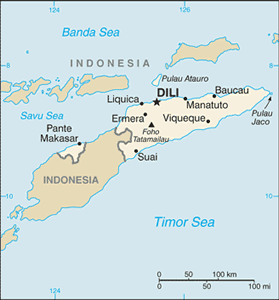The Geography of Timor-Leste
The Geography of Timor-Leste
Timorese Geography
Location: Southeastern Asia, northwest of Australia in the Lesser Sunda Islands at the eastern end of the Indonesian archipelago; note - Timor-Leste includes the eastern half of the island of Timor, the Oecussi (Ambeno) region on the northwest portion of the island of Timor, and the islands of Pulau Atauro and Pulau Jaco
Geographic coordinates: 8 50 S, 125 55 E
Map references: Southeast Asia
Area: total: 15,007 sq km land: NA sq km water: NA sq km
Area - comparative: slightly larger than Connecticut
Land boundaries: total: 228 km border countries: Indonesia 228 km
Coastline: 706 km
Maritime claims: territorial sea: 12 nm contiguous zone: 24 nm exclusive fishing zone: 200 nm
Climate: tropical; hot, humid; distinct rainy and dry seasons
Terrain: mountainous
Elevation extremes: lowest point: Timor Sea, Savu Sea, and Banda Sea 0 m highest point: Foho Tatamailau 2,963 m
Natural resources: gold, petroleum, natural gas, manganese, marble
Land use: arable land: 8.2% permanent crops: 4.57% other: 87.23% (2005)
Irrigated land: 1,065 sq km (2003)
Natural hazards: floods and landslides are common; earthquakes; tsunamis; tropical cyclones
Environment - current issues: widespread use of slash and burn agriculture has led to deforestation and soil erosion
Environment - international agreements: party to: Biodiversity, Climate Change, Climate Change-Kyoto Protocol, Desertification signed, but not ratified: none of the selected agreements
Geography - note: Timor comes from the Malay word for "East"; the island of Timor is part of the Malay Archipelago and is the largest and easternmost of the Lesser Sunda Islands


